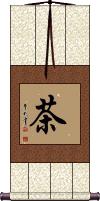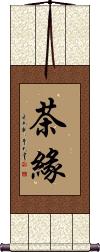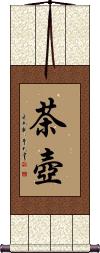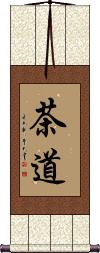Many custom options...
And formats...

茶 in Chinese / Japanese...
Buy an 茶 calligraphy wall scroll here!
Personalize your custom “茶” project by clicking the button next to your favorite “茶” title below...
茶 means tea. It can refer to prepared tea (ready-to-drink) or dry tea leaves.
The origin of tea is China but the same character is used in Japanese Kanji, and old Korean Hanja with the exact same meaning. Japanese and Korean even borrowed the pronunciation from Chinese (pronounced “cha” in all three languages).
It's said that an early doctor (or herbologist) in ancient China kept poisoning himself as he tried different new herb concoctions. He invented tea as a means to detoxify himself as he recovered from 1 of the 76 times he nearly poisoned himself to death. Tea is seen not just as a drink but as a form of medicine used to remove impurities from the body.
The word “chai” (used in many languages to refer to various teas) is derived from this Chinese word.
茶 also means camellia, as Asian teas are often based on the leaves of camellia plant varieties.
Tea Fate
茶緣 is a special title for the tea lover. This kind of means “tea fate,” but it's more spiritual and hard to define. Perhaps the tea brought you in to drink it. Perhaps the tea will bring you and another tea-lover together. Perhaps you were already there, and the tea came to you. Perhaps it's the ah-ha moment you will have when drinking the tea.
I've been told not to explain this further, as it will either dilute or confuse the purposefully-ambiguous idea embedded in this enigma.
I happen to be the owner of a piece of calligraphy written by either the son or nephew of the last emperor of China, which is the title he wrote. It was given to me at a Beijing tea house in 2001. 茶緣 is where I learned to love tea after literally spending weeks tasting and studying everything I could about Chinese tea. I did not understand the significance of the authorship or the meaning of the title at all. Some 10 years later, I realized the gift was so profound and had such providence. Only now do I realize the value of a gift that it is too late to give proper thanks for. It was also years later that I ended up in this business and could have the artwork properly mounted as a wall scroll. It has been borrowed for many exhibitions and shows and always amazes native Chinese and Taiwanese who read the signature. This piece of calligraphy I once thought was just a bit of ink on a thin and wrinkled piece of paper, is now one of my most valued possessions. And fate has taught me to be more thankful for seemingly simple gifts.
Tea Pot
The Way of Tea
茶道 means The Way of Tea (literally, “tea way”) in Chinese and Japanese.
This may refer to a tea ceremony or a general lifestyle of tea preparation and drinking.
In Japanese, this can be pronounced sadō or chadō (seems that sadō refers more often to a tea ceremony, and chadō when it's the Way of Tea).
茶道 is also used in the Buddhist context with the same meaning as the Way of Tea.
Not the results for 茶 that you were looking for?
Below are some entries from our dictionary that may match your 茶 search...
| Characters If shown, 2nd row is Simp. Chinese |
Pronunciation Romanization |
Simple Dictionary Definition |
茶 see styles |
chá cha2 ch`a cha cha ちゃ |
More info & calligraphy: Tea(1) (See お茶・1) tea; (2) tea plant (Camellia sinensis); (3) (See 茶道) tea preparation; making tea; (4) (abbreviation) (See 茶色) brown; (noun or adjectival noun) (5) (archaism) (See 茶化す) mockery; (surname, given name) Cha Tea; tea-leaves; translit. ja, jha. |
茶壺 茶壶 see styles |
chá hú cha2 hu2 ch`a hu cha hu chatsubo ちゃつぼ |
More info & calligraphy: Tea Pottea jar; tea urn |
茶道 see styles |
chá dào cha2 dao4 ch`a tao cha tao chadou / chado ちゃどう |
More info & calligraphy: The Way of Teatea ceremony; Way of Tea; sadō; (place-name) Chadō the way of tea |
お茶 see styles |
ocha おちゃ |
(1) (polite language) tea (usu. green); (2) tea break (at work); (3) tea ceremony |
ニ茶 see styles |
nicha にちゃ |
(female given name) Nicha |
一茶 see styles |
issa いっさ |
(person) Kobayashi Issa (1763-1827) |
万茶 see styles |
macha まちゃ |
(female given name) Macha |
三茶 see styles |
sancha さんちゃ |
(place-name) Sangenjaya (abbreviation) |
上茶 see styles |
joucha / jocha じょうちゃ |
(surname) Jōcha |
下茶 see styles |
shimocha しもちゃ |
(place-name, surname) Shimocha |
中茶 see styles |
nakachiya なかちや |
(surname) Nakachiya |
二茶 see styles |
niichii / nichi にいちぇ |
(personal name) Niiche |
兎茶 see styles |
usa うさ |
(surname) Usa |
冠茶 see styles |
kabusecha かぶせちゃ |
kabusecha; mild green tea which has been lightly screened from sunlight for 1-3 weeks before picking |
冷茶 see styles |
reicha / recha れいちゃ |
cold tea; cold brew tea |
利茶 see styles |
kikicha ききちゃ |
(1) tea tasting; tea-tasting; (2) tea-tasting contest |
化茶 see styles |
huà chá hua4 cha2 hua ch`a hua cha kesa |
tea obtained by monastic begging and the offering of exhortation or instruction. |
千茶 see styles |
chisa ちさ |
(female given name) Chisa |
半茶 see styles |
hancha はんちゃ |
(given name) Hancha |
口茶 see styles |
kuchija くちぢゃ |
adding more tea; adding fresh leaves to used ones in a teapot |
古茶 see styles |
furucha ふるちゃ |
last year's tea; (surname) Furucha |
合茶 see styles |
gouja / goja ごうじゃ |
(place-name) Gouja |
名茶 see styles |
meicha / mecha めいちゃ |
fine tea; brand-name tea; famous tea; choice tea; well-known brand of quality green tea |
呈茶 see styles |
teicha / techa ていちゃ |
(polite language) serving tea (esp. in tea ceremony) |
品茶 see styles |
pǐn chá pin3 cha2 p`in ch`a pin cha |
to taste tea; to sip tea |
喜茶 see styles |
kiteぃ きてぃ |
(female given name) Kiti |
喝茶 see styles |
hē chá he1 cha2 ho ch`a ho cha |
to drink tea; to get engaged; to have a serious conversation; (fig.) to have a meeting with state security agents (to be warned to behave "responsibly") |
喫茶 see styles |
kissa きっさ |
(1) tea drinking; (2) (abbreviation) (See 喫茶店) teahouse; tearoom; coffee lounge; coffee shop; (rather formal) cafe |
団茶 see styles |
dancha だんちゃ |
cake tea (e.g. Pu-erh tea) |
坊茶 see styles |
boucha / bocha ぼうちゃ |
(given name) Boucha |
Click here for more 茶 results from our dictionary
The following table may be helpful for those studying Chinese or Japanese...
| Title | Characters | Romaji (Romanized Japanese) | Various forms of Romanized Chinese | |
| Tea | 茶 | cha | chá / cha2 / cha | ch`a / cha |
| Tea Fate | 茶緣 茶缘 | chá yuán / cha2 yuan2 / cha yuan / chayuan | ch`a yüan / chayüan / cha yüan | |
| Tea Pot | 茶壺 茶壶 | cha tsubo / chatsubo | chá hú / cha2 hu2 / cha hu / chahu | ch`a hu / chahu / cha hu |
| The Way of Tea | 茶道 | cha dou / chadou / cha do | chá dào / cha2 dao4 / cha dao / chadao | ch`a tao / chatao / cha tao |
| In some entries above you will see that characters have different versions above and below a line. In these cases, the characters above the line are Traditional Chinese, while the ones below are Simplified Chinese. | ||||
Successful Chinese Character and Japanese Kanji calligraphy searches within the last few hours...







